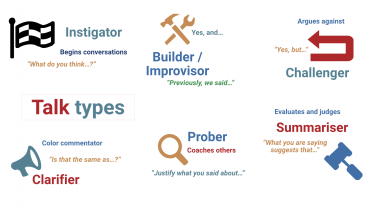Teaching infographics #2 – VOCAL: Traits of a Successful Online Teacher
This graphic is a quick guide for some common sense approaches to teaching online. The graphic comes from this post, which has a short discussion attached to it with a few more leads toward better practice in teaching online. It’s worth the quick visit. Other infographics in this series: Teaching infographics #1 – 9 tips
- Published in Infographics, Instruction

10 routines for teaching online – #4 Talk types
The idea of ‘talk types’ is loosely related to Cooperative learning group roles, though the functions described in ‘talk types’ are less based on leadership skills, and more based on communication skills: both of which are vital in any workforce. There are six talk types that your students can use as a supplement to their
- Published in Instruction, Routines

Differentiating Instruction in Your LMS
Anyone who has been in the world of education for any significant amount of time knows that blanketed instruction, or teaching all students in the same way and expecting them all to learn the same thing, just doesn’t work. We also know, unfortunately, that providing individualized instruction for every student in a class, or even
- Published in Teaching with Technology

Tips for Managing Breakout Groups in Collaborate Ultra #1 – Assigning Students and Communicating with them
Knowing your way around in breakout groups is crucial for the seamless administration of online collaborative activities. This post shares tips regarding assigning students and communicating with them. The next post will share tips for monitoring students and ending the groups. Assigning Students 1. Assign multiple students
- Published in Blackboard, Collaborate Ultra, Teaching with Technology

Teaching infographics #2 – Using video to assess student attention
Like many of you, I have Facebook and LinkedIn account, and I’m a member of a lot of educational groups on these two giant social media platforms. A lot of these groups post some excellent gems of information in the form of infographics. I particularly like this one because it’s all about respecting
- Published in Assessment, Infographics, Instruction, Routines

10 routines for teaching online – #5 student shoe box
During your course, it’s always good to get to know your students. In a class of 24 students, you can do this activity to start your first 50-minute session and end your second 50-minute session. It’s quite simple. For each of these sessions, one student shows two to three artifacts that are personally important to
- Published in Instruction, Routines
Subscribe to our Newsletter
Recent Posts
Teaching infographics #2 – VOCAL: Traits of a Successful Online Teacher
This graphic is a quick guide for some common s...10 routines for teaching online – #4 Talk types
The idea of ‘talk types’ is loosely...
Differentiating Instruction in Your LMS
Anyone who has been in the world of education f...
Authors
- Andy Steele (9)
- Azim Ahmed (12)
- Christine Lampe (3)
- Gemma Escott (1)
- Larry Davies (25)
- Mahinour Ezzat (1)
- Raghad Nihlawi (16)
- Samantha McDonald Amara (16)
- Sarah Whittaker (55)
- Silishi Noushad (1)
Categories
- Adult Learning
- Assessment
- Blackboard
- Blackboard
- BookWidgets
- Collaborate Ultra
- Ed Tech
- Grade Center
- ILC
- Infographics
- Instruction
- Learning Technology Tools
- Microsoft
- Mobile OS
- Mobile Technology
- Nearpod
- News & Events
- PLAs
- Professional Development
- Routines
- Teaching with Technology
- Uncategorized
- Webinars
Tag Cloud
Archives
- February 2021
- November 2020
- October 2020
- September 2020
- August 2020
- July 2020
- June 2020
- May 2020
- April 2020
- March 2020
- February 2020
- January 2020
- December 2019
- November 2019
- October 2019
- September 2019
- August 2019
- June 2019
- May 2019
- April 2019
- March 2019
- February 2019
- March 2016
- January 2016
- November 2015
- October 2015
- June 2015
- May 2015
- March 2015
- February 2015
- January 2015
- November 2014
- October 2014
- September 2014
- August 2014
- June 2014
- May 2014
- April 2014
- March 2014
- February 2014
- January 2014
- September 2013
- January 2013
- December 2012
- November 2012
- October 2012
- July 2012
- April 2012
- March 2012
